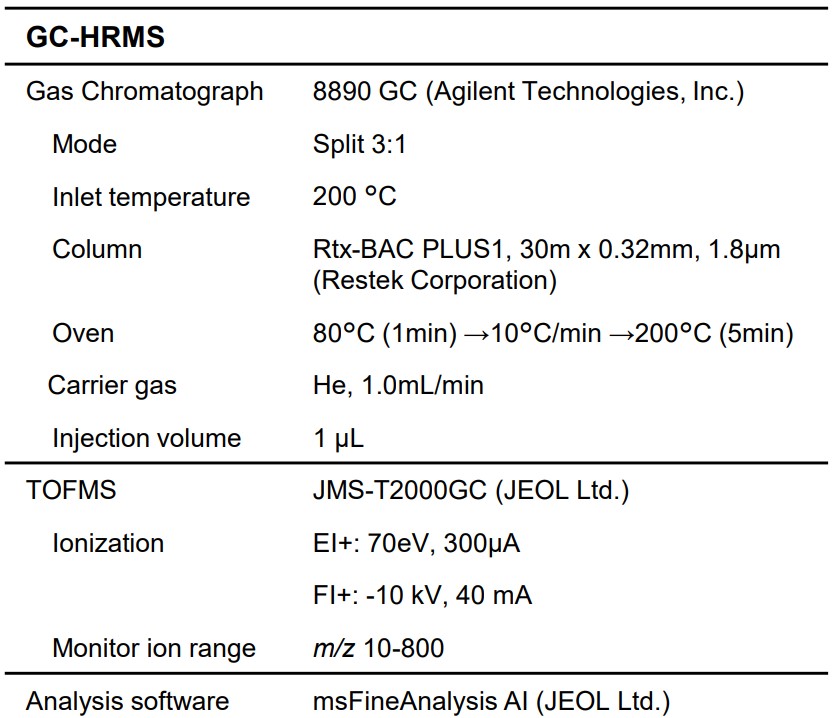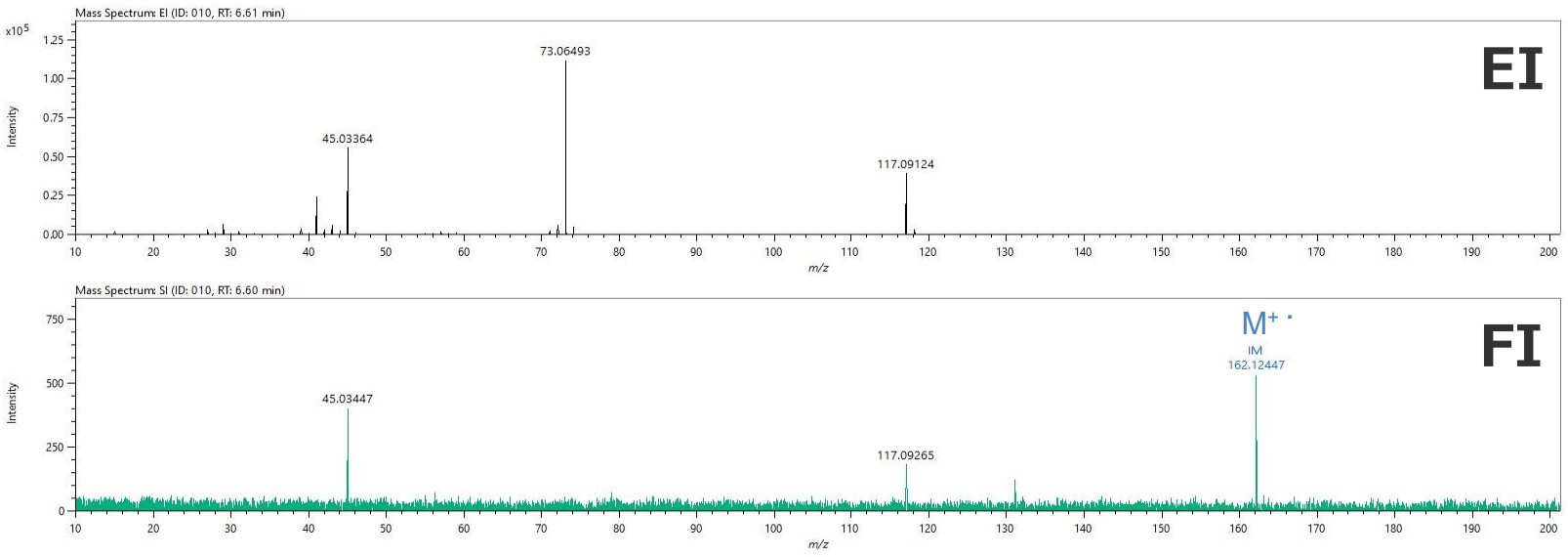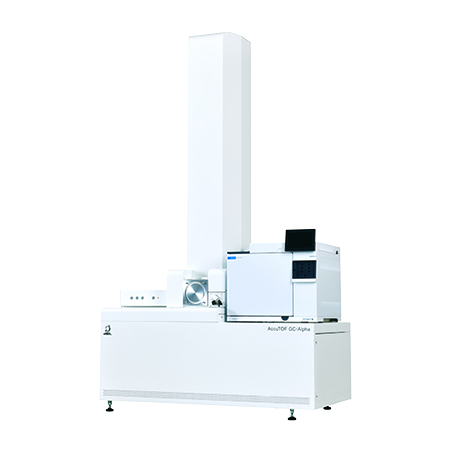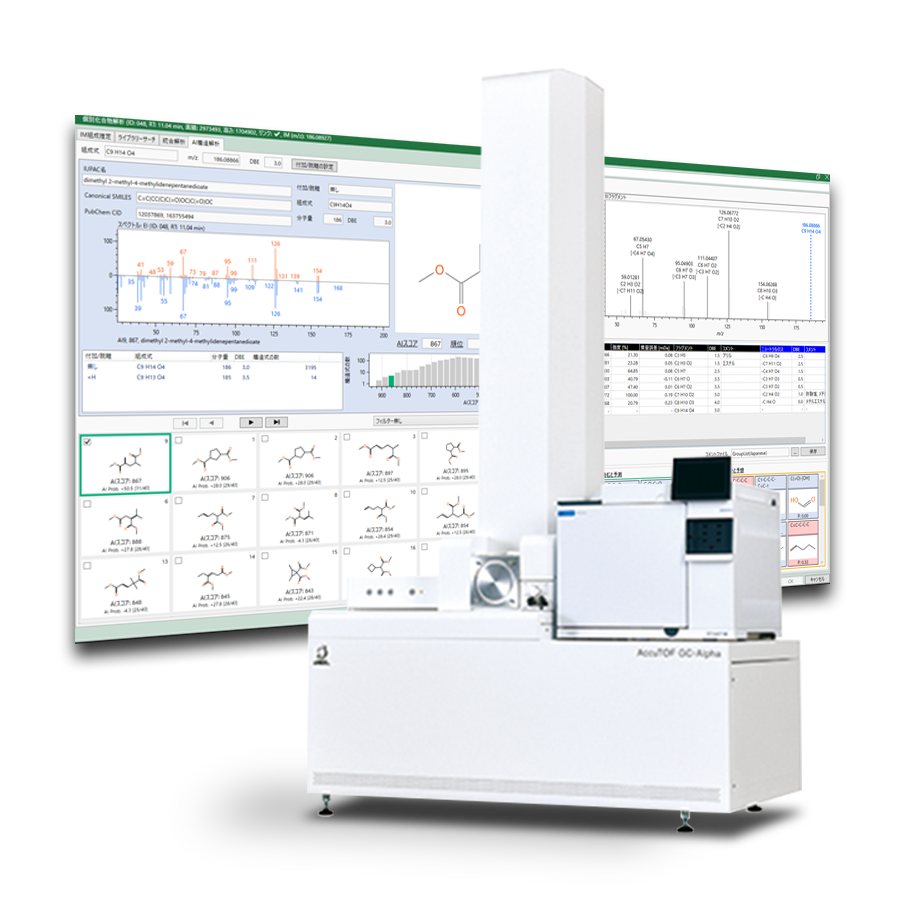Qualitative Analysis of Impurities in a Solvent for Semiconductor Fabrication using msFineAnalysis AI
MSTips No.434
Introduction
Reliability of semiconductor devices is determined by the level of cleanliness of silicon wafers. Therefore, it is critical to prevent contamination from the impurities in cleaning solutions. To process any cleaning solution to an ultra-pure level, it is important to identify the chemical components of impurities to be removed. For this purpose, gas chromatography-mass spectrometer (GC-MS) is widely used.
Recently, techniques used for qualitative analysis are increasingly sophisticated, including exact mass analysis using GC-high resolution mass spectrometer (GC-HRMS), NIST database of electron ionization (EI) mass spectra, and molecular ion analysis using soft ionization (SI). Meanwhile, volumes of data acquired from exact mass analysis are enormous, requiring expertise in MS data analysis and vast amounts of time for interpretation.
JEOL’s latest analytical software, msFineAnalysis AI, is designed to provide speedy analysis of GC-HRMS data acquired by both EI and SI, determine chemical formulas, and predict chemical structures. In this work, we used msFineAnalysis AI to identify impurities in 2-methoxy-1-methylethyl acetate (PGMEA), a cleaning solution for wafer surfaces.
Measurement
A commercial PGMEA (≥99.5%) was used as a sample. As a GC column, Rtx-BAC PLUS1 was used because impurities were expected to be highly polar, similarly to PGMEA. EI and FI (Field Ionization) were used as ionization methods. msFineAnalysis AI was subsequently used for analysis of the acquired data. Table 1 shows the measurement conditions.
Results and Discussion
Figure 1 shows the total ion current chromatograms (TICCs) of EI and FI. Other than air and PGMEA, a total of 12 components, considered to be impurities, were detected. These components other than air and water were verified in both EI and FI TICCs. For some components, their formulas predicted from the molecular ions did not agree with the results of NIST database search.
However, msFineAnalysis AI contains an AI database of EI mass spectra estimated from the chemical structures in addition to the NIST database. These components, when examined against the AI database, turned out to be the compounds, which were in good agreement with fragment ions patterns and had the chemical formulas predicted by molecular ions.
Water molecules, which can be easily mixed with PGMEA, as well as 1-methoxypropan-2-ol[1], which is used as a synthetic raw material for PGMEA, were identified as impurities.
2-methoxypropyl acetate, a structural isomer of PGMEA, was also identified as an impurity.
Table 1. Measurement conditions


Figure 1. EI and FI TICCs of PGMEA

Figure 2. EI and FI mass spectra of the component at a retention time of 6.61 minutes
Upper: EI, Lower: FI
Figures 2 and 3 respectively show the mass spectra and predicted chemical structures of the peak marked by ▼ in Figure 1, which was detected at a retention time of 6.61 minutes.
No molecular ion was detected in the EI mass spectrum in Figure 2. The molecular ion of this component was detected in the FI mass spectrum, demonstrating the importance of using soft ionization as well. The exact mass of the molecular ion detected suggested C8H18O3 as its chemical formula. NIST database search for the EI mass spectrum did not result in any compounds showing a similarity of 750 or more.
However, the AI structural analysis in Figure 3 resulted in 3-(3-hydroxybutan-2-yloxy)butan-2-ol, which had a chemical formula of C8H18O3 and also showed good agreement between the measured and AI predicted EI fragment patterns.

Figure 3. EI and FI mass spectra of the component at a retention time of 6.61 minutes
Summery
The results of this work demonstrate the effectiveness of msFineAnalysis AI. It is a powerful and efficient tool for qualitative analysis, saving time and labor in chemical formula determination and chemical structure prediction. In addition to qualitative analysis of impurities in organic solvents including PGMEA, the GC-HRMS system with msFineAnalysis is expected to be effective for qualitative analysis of organic contaminants on semiconductor surfaces by examining ROSE test solutions before and after cleaning semiconductor devices.
Reference
[1] Arif Hussain, Yus Donald Chaniago, Amjad Riaz, Moonyong Lee,. Ind. Eng. Chem. Res. 2019, 58, 6, 2246−2257.
DOI: 10.1021/acs.iecr.8b04052
Solutions by field
Related products
Are you a medical professional or personnel engaged in medical care?
No
Please be reminded that these pages are not intended to provide the general public with information about the products.


